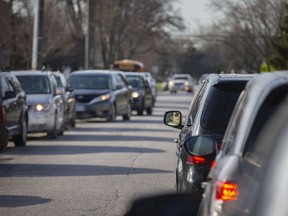Philip Cross: In the waron cars, the suburbs strikeiI back
Only the very naïve think we will soon end our dependence on autos AM
Author of the article:
Publishing date:
Aug 26, 2022 • 3 days ago • 4 minute read •

Canadian drivers are experiencing a double dose of frustration this summer: record gas prices combined with a return to the pre-COVID traffic congestion that for years now has been making it so hard to get around our major cities. When green governments aren’t cavalierly dismissing the exasperating inconvenience to drivers they’re actually embracing it as a strategy for getting people to switch to mass transit. Trouble is, businesses bear the brunt of congestion costs. Estimates are that up to 40 per cent of traffic consists of commercial vehicles. Businesses count on timely deliveries to keep their factories supplied and shelves stocked and to satisfy burgeoning consumer demand for home delivery. For most firms, mass transit is simply not an option. When traffic chronically snarls their only alternative is to move everything but delivery out of city centres.
Story continues below
Most of the disruption to traffic flows is the result of government-erected barriers. Some of these impediments are structural, such as narrower streets, bike lanes and so-called “traffic-calming” measures. Add the seasonal disruption from construction work and getting around becomes a nightmare. A member of Montreal’s ruling party admitted a couple of years ago that barriers were deliberately configured to frustrate drivers. A similar mindset is at work in Ottawa, where I live. The federal government’s imperious National Capital Commission (NCC) seems to want to be the No Cars Commission, closing many of its parkways to vehicles on the flimsy excuse of encouraging outdoor exercise.
Urban planners and environmentalists seem unaware that by making Canada’s urban cores vehicle un-friendly they are pushing Canadian households and firms to live and work outside of large cities, which increasingly is what they’re doing. Earlier this year Statcan reported that population growth between 2016 and 2021 was faster in the distant suburbs (meaning a drive of 30 minutes or more from downtown) of Toronto, Montreal, and Vancouver than their overall growth. In Toronto, these ex-urbs accounted for three-quarters of all gains, as prospective homebuyers searched further out for cheaper houses. Living so far out puts many people beyond the reach of the mass transit systems governments are pouring billions into despite ridership now averaging less than two-thirds of pre-pandemic capacity. Forcing people to move out of cities inevitably increases their carbon footprint, the exact opposite of what planners claim to want to achieve.
Story continues below
Many households moving out are following employers re-locating to avoid the traffic congestion and barriers that raise transportation and inventory costs. Firms’ use of trucks increased during the pandemic. Though drivers remain in short supply across North America Amazon recently announced the purchase of 100,000 new delivery trucks. Highways remain key. In their book The Great Disruption, Rick Smith and Mitch Free recount how New York firms in the Bronx and Queen’s report that “easy access via highway to everywhere in the region” is what they liked most about their location.
Business people intuitively understand the cost of traffic tie-ups, a notion that escapes most government bureaucrats. My barber once complained to the city that street construction threatened his business. A local bureaucrat answered that slower traffic would allow bored drivers to pay attention to local businesses. My barber countered — correctly, as it turned out — that after one bad experience frustrated drivers would take alternative routes to avoid that street altogether.
- Philip Cross: Higher profits are not driving inflation
- Philip Cross: The resurgence of rural Canada
- Philip Cross: Wage hikes risk more inflation
Provincial governments, which are more in touch with how ordinary people live than the ideologues running the federal government’s agenda, are building more highways outside of city centres. Ontario Premier Doug Ford, who has decried bureaucrats’ “war on cars,” was re-elected on a promise to build both Highway 413 connecting the York and Halton regions and the Bradford Bypass project extending Highway 400. Quebec’s François Legault has pledged to build a tunnel between Quebec City and its south shore suburbs and re-build or extend two major motorways. Improving roads outside of downtowns reflects recent forecasts that Quebec’s population growth will move away from Montreal to outlying regions, a shift that perfectly accords with Legault’s political strategy of capturing rural and suburban seats while ceding downtown votes to Quebec’s many left-wing parties.
Improving road transportation is a proven winning electoral strategy in Canada. It also recognizes reality. Only the very naïve think we will soon end our dependence on autos. People need them for work and for personal errands. The charitable organization Vehicles for Change estimates that having access to a vehicle raises a person’s pay by up to $8,000 a year, while over half of people also use their vehicle for shopping and picking up children, making mass transit a poor substitute. Trucking is even more important to businesses, as firms increasingly move out of city centres to reduce costs and ensure timely delivery.
Those are the hard facts where the rubber meets the road.
Philip Cross is a senior fellow at the Macdonald-Laurier Institute.
